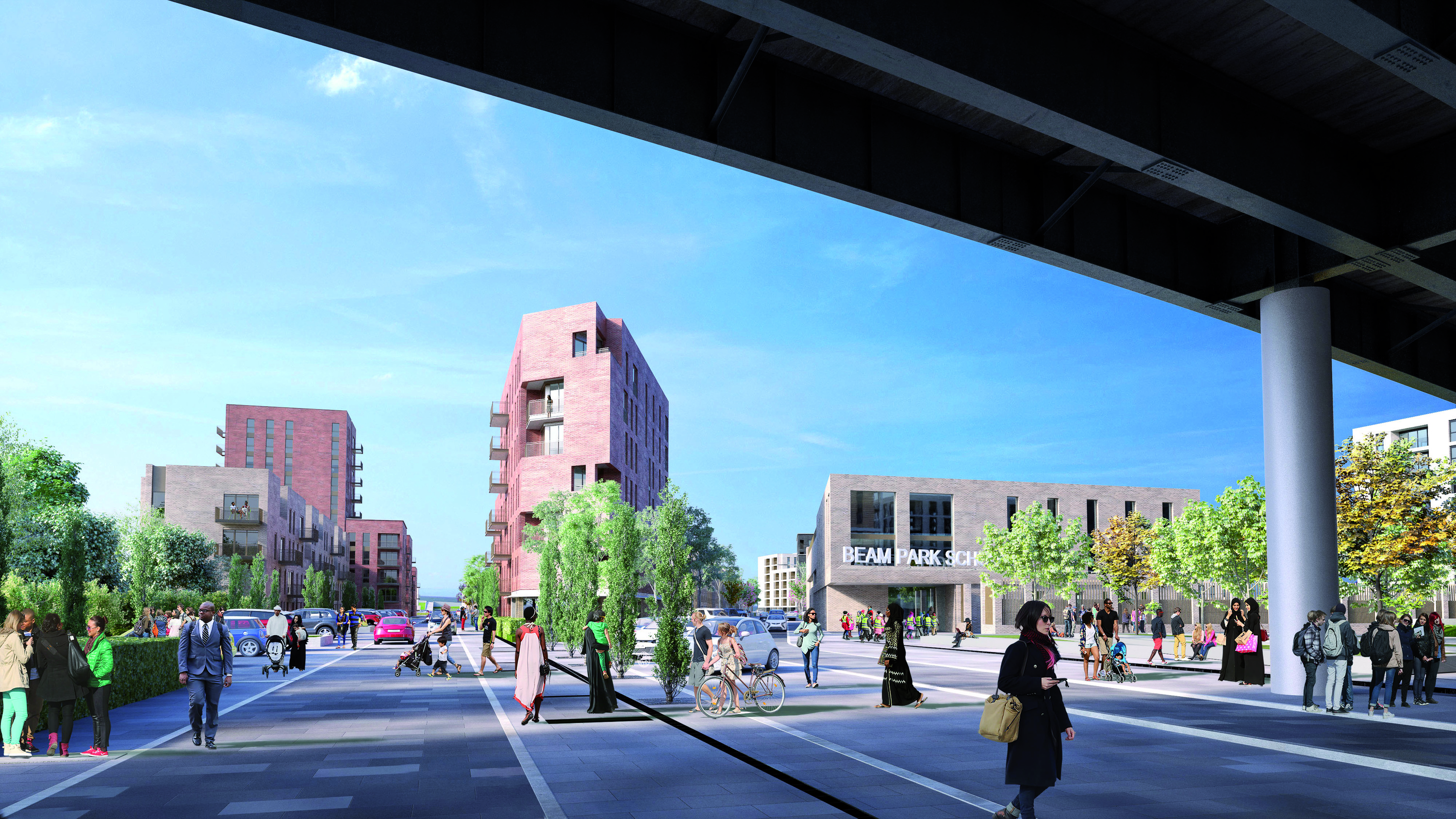Project showcase
Beam Park

Beam Park is the culmination of a significant collaboration between public and private sector bodies to accelerate housing delivery for two London boroughs on a large, complex and constrained brownfield site. Delivered through a 50/50 joint venture from Countryside and L&Q, Beam Park provides 3,000 homes, infrastructure and supporting amenities over 31 hectares of the former Dagenham Ford site, Rainham. 50 per cent of homes are affordable (Shared Ownership, LAR, LLR). The GLA- owned site stretches across two London boroughs; Barking and Dagenham to the west and Havering to the east. Unlike most regeneration areas, there was little existing context. The ex-industrial site had lain derelict and empty for 15 years; severed and delimited by river, road and rail infrastructure. Further site issues included ground contamination, flood risk, high- pressure gas mains and a major foul sewer.
However, these constraints played a fundamental role in the placemaking strategy. The brief was outlined by the GLA in 2014; the location was described as an unprecedented opportunity to create a new urban community of 2,000- 3,000 homes with transport links to Central London. The requirement was to transform disused brownfield into an attractive, well connected, sustainable place for people to live, work and socialise. Open space forms 77% of the masterplan, 40% of which is publicly accessible. Beam Park provides a complete framework for living that includes a new rail station, shops, cafés, restaurants, workplace, leisure, community centre, medical facilities and two primary schools, one for each borough.
Describe the context and brief for this place?
Beam Park is the culmination of a significant collaboration between public and private sector bodies to accelerate housing delivery for two London boroughs on a large, complex and constrained brownfield site. Delivered through a 50/50 joint venture from Countryside and L&Q, Beam Park provides 3,000 homes, infrastructure and supporting amenities over 31 hectares of the former Dagenham Ford site, Rainham. 50 per cent of homes are affordable (Shared Ownership, LAR, LLR). The GLA-owned site stretches across two London boroughs; Barking and Dagenham to the west and Havering to the east. Unlike most regeneration areas, there was little existing context.
The ex-industrial site had lain derelict and empty for 15 years; severed and delimited by river, road and rail infrastructure. Further site issues included ground contamination, flood risk, high-pressure gas mains and a major foul sewer. However, these constraints played a fundamental role in the placemaking strategy.
The brief was outlined by the GLA in 2014; the location was described as an unprecedented opportunity to create a new urban community of 2,000-3,000 homes with transport links to Central London. The requirement was to transform disused brownfield into an attractive, well connected, sustainable place for people to live, work and socialise. In addition, the proposals needed to help regenerate the surrounding area, while encouraging a positive change in the perception of the London Riverside area. Construction will be phased over 10 years. Phase 1, consisting of 640 homes, Station Square and Beam Park Rail Station, commenced in February 2019.
Describe your design for this place and how it will contribute to urban life?
A collection of distinct brick-and-mortar architectural typologies along typical London streets respond to varied landscape settings, forming a townscape that reflects and supports the rhythm and diversity of East London life. A hierarchy of streets and squares create a coherent urban experience, punctuated by marker buildings to aid navigation and create special moments within the masterplan. Stitching the neighbourhood into its environment was key; massing and landscape strategies were designed to establish a positive dialogue with the existing context and adjacent sites.
Open space forms 77% of the masterplan, 40% of which is publicly accessible. Diverse green spaces; such as the 3.5-hectare Central Park, Beam Square and parkland lining the north and south of the site; encourage outdoor activity, create social opportunities and enhance the ‘remembered journey’ from street to front door.
Accommodation includes villas, apartment blocks and low-density terraces of family homes, 11- storey warehouse buildings, and an 8 to16- storey development at Station Square, the civic centre of Beam Park. Homes range from studios to 4-bed townhouses in a mix of tenures. Building design was informed by the character of London’s existing grain and the site’s industrial heritage. For example, warehouse buildings reference the vertical rigour of the factory buildings that once occupied the site, while the scale and massing of the terraces were influenced by London’s Georgian vernacular. Beam Park provides a complete framework for living that includes a new rail station, shops, cafés, restaurants, workplace, leisure, community centre, medical facilities and two primary schools, one for each borough.
What was your process in coming up with the design? What research, consultation, workshops or conversations did you undertake?
The overarching design driver was understanding how we could shape a place where none existed before. We started by examining London’s existing grain. The character of the city’s most enduring neighbourhoods is defined by a common language of streets, squares, buildings, markers, materials and active street frontages. Spaces, uses and buildings come together to create public realm settings. A street’s particular feel may result from correspondences or contrasts between buildings, scale and materials; the building typologies help to define the character of the street. Similarly, the street provides an outlook for the buildings. Together, these form a setting, and the interplay of varied settings form a rich townscape.
Success at planning hinged on clear, transparent and honest communication between the design/ client team and LB Havering, LB Barking & Dagenham, GLA, TfL, Network Rail, local businesses and residents. We had to understand and satisfy their differing needs and priorities. Public consultation helped to fine-tune the proposals to better suit local needs. Engagement details were published in a community newsletter, dedicated project website, Twitter account and adverts in the Romford Recorder and Barking & Dagenham Post. Events were held at Heathway Shopping Centre, Mardyke Community Centre, Rainham Village Christmas Fayre, as well as workshops at Castle Green Leisure Centre and Mardyke Community Centre. London’s Deputy Mayor, Jules Pipe, gave the resolution to grant in September 2018, citing the scheme as “a liveable and attractive new neighbourhood… that could play a crucial role in London’s economy for decades to come.”
How does your design respond to future changes in demographics, transport and the climate emergency to create a resilient place?
While a series of outdoor amenity spaces bring people together through leisure and reintroduce ecology to the site, these green spaces also provide a first line of defence against fluvial and tidal flooding from the River Beam. It is predicted that this may pose an increased risk as temperatures rise. The 3.5-hectare Central Park plays an important role in mitigating flood risk, while creating a valuable public asset out of the gas mains exclusion zone. In addition, parkland lining the site boundaries works together with a green SUDs network of streetscape swales and buffer planting to help combat flooding. Open space totals 77% of the site, with a GLA Urban Greening Factor of 0.4. The thermal mass associated with concrete frame and masonry construction as well as green roofs helps to maintain even temperatures, minimising heating and cooling loads to reduce demand on building services systems and energy consumption overall.
Beam Park is a walkable neighbourhood that increases urban mobility. In addition, the new rail station vastly improves the Public Transport Accessibility Level (PTAL). Road traffic emissions are estimated to be below the Transport Emissions Benchmark; as such, Beam Park achieves air quality neutral with regard to transport emissions.
Beam Park has been designed as an age-inclusive community where residents can put down roots; upsizing or downsizing within the neighbourhood, depending on their stage in life. Mixed-tenure homes in a range of accommodation, from studio apartments to 4-bed family townhouses, set the scene for a diverse East London community.
Festival of Pineapples
24-26 February 2026
Pineapples prize giving night
April
Pineapples at Festival of Place
10 June 2026
© The Pineapples - Tweak Ltd. 124 City Road, London, EC1V 2NX. Tel: 020 3326 7238




